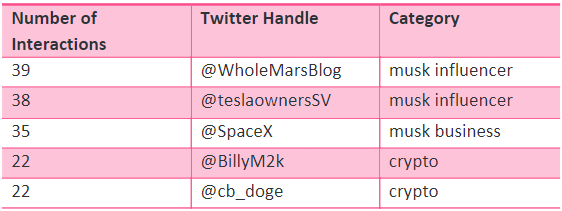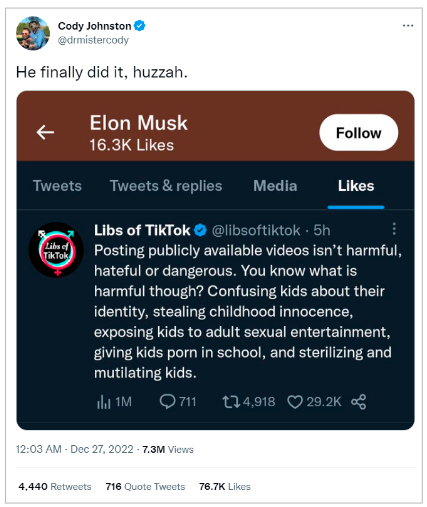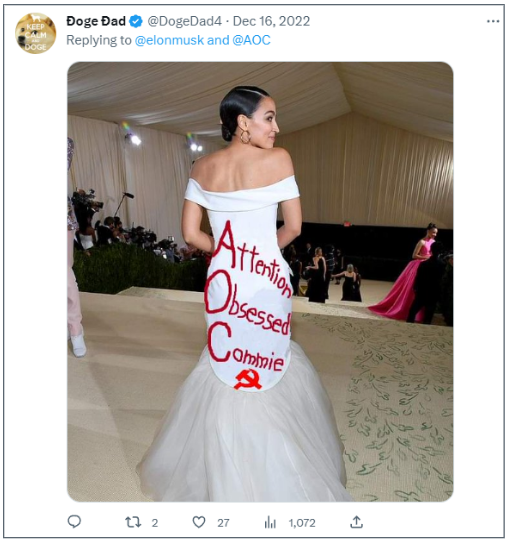Friends in the ‘right’ places: An analysis of Elon Musk’s Twitter interactions before and after acquiring the platform
By: Clara Martiny
31 January 2023
_________________________________________________________________________________
On October 27, 2022, Elon Musk became the owner and CEO of Twitter after a months-long acquisition process highly covered by news media and closely watched by Twitter’s long-time users. Initial promises by Musk included ‘open sourcing’ Twitter’s algorithms, taking down bots and spam, and a vigorous commitment to free speech.
Three months, some broken promises, and countless layoffs later, Twitter has lost its top advertisers and its revenue has tanked. In a confusing set of decisions, Musk suddenly banned (and then reinstated) tech journalists covering Twitter, reinstated (and then banned) Kanye West and white nationalist Nick Fuentes, and then reinstated dozens of accounts known to spread hate and disinformation. Even more concerning, Musk (whose own Twitter followership has grown to 126.3 million) has been interacting with these types of accounts, amplifying their content to his followers and giving a platform to narratives spreading disinformation and hateful rhetoric.
With heightened attention on who he is interacting with and why, ISD aimed to understand how Elon Musk’s Twitter interactions have changed since the initial announcement that Musk was looking to acquire the social media platform.
A jump in activity: Before and after
Analysts found that in the three months before Musk officially acquired Twitter (July 31 to October 27, 2022), he barely interacted with any right-wing news media or users spreading disinformation and hate on the platform. Instead, he interacted with accounts that analysts identified as ‘Musk influencers’ – users who post positive news about Musk’s business ventures and accomplishments.

Figure 1: Example of a Twitter user analysts categorized as a ‘Musk influencer.’
This changed significantly after October 27. Following his acquisition of Twitter, ISD determined that one of the largest categories of accounts Musk interacted with were identified as ‘right-wing’ accounts. This category encompasses a range of users, from those employed by right-wing news media, to users who broadcast strong right-wing or far-right views, to users known to peddle conspiracy theories and disinformation narratives typically associated with the right wing.
To conduct this analysis, ISD collected and counted Musk’s Twitter interactions – replies, quote tweets, and retweets – from July 31, 2022, to January 19, 2023, splitting the dataset into two three-month segments (‘during’ and ‘post’ Twitter negotiations). This was done using Method52, a data collection and analysis capability built by CASM Technology, and the Twitter public API, which limits historic actor-based collections to the last 3,400 tweets posted or retweeted by the user. In total, analysts collected 1,000 tweets in the July 31 – October 27, 2022, time period and 2,303 tweets in the October 27 – January 19, 2023, timeframe. This means that Musk was posting twice as much on Twitter after he acquired it. Musk interacted with 292 unique users a total of 716 times in the first timeframe and 726 unique users a total of 1,802 times in the second time period.
Pre-acquisition behavior suggests a more cautious Musk
Analysts then identified the top 50 Twitter users (by interaction count) Musk interacted with in each time period, putting each user into one of 12 different categories. The users were categorized manually based on Twitter bios, their recent tweets, how they’re connected to Musk, and relevant information obtained through Google searches.

Figure 2: An example of the initial datasets. This table shows the top five Twitter accounts ordered by times Musk interacted with them while negotiating his acquisition of Twitter, July 31 to October 27.
In the July 31 – October 27, 2022 dataset, analysts observed Musk mostly interacting with users in the Musk influencer category, suggesting that he was potentially trying to amplify his brand and public image during the negotiations. The next top three categories included ‘crypto,’ ‘Musk investor,’ and ‘Musk business.’ Only two right-wing accounts were identified in the top 50 – user @stillgray (Ian Miles Cheong) and @SKMorefield (Scott Morefield)– two conservative journalists known to spread disinformation and amplify hateful right-wing talking points. Analysts also observed Musk beginning to interact with the journalists who would eventually publish the Twitter Files – a set of internal Twitter documents made public by Musk allegedly showing the company ‘silencing’ conservative accounts.
Shift of power and shift of Twitter interactions
The October 27, 2022, to January 19, 2023 dataset reveals a significant shift in the types of accounts Musk interacted with after acquiring Twitter. Of the 820 Twitter interactions Musk had with the new set of top 50 users during this time period, 19.7 percent of interactions were with right-wing accounts. The top users he most interacted with in this category included Ian Miles Cheong (49 times), ‘anti-woke’ journalist Glenn Greenwald (22 times), pro-Trump activist and Judicial Watch president Tom Fitton (13 times), right-wing influencer @catturd2 (13 times), and conservative news satire website The Babylon Bee (12 times). This is a stark contrast with the 1.1 percent interaction rate with right-wing accounts from the July 31 – October 27 period.
In the past few years, Musk’s activity on the platform has become more and more problematic. But now that he has become the owner of Twitter, his behavior is more watched than ever. When looking at the full dataset of tweets post-Twitter acquisition, analysts observed concerning interactions that differed from the first dataset. For example, Musk interacted with accounts such as Tim Pool, ALX, Kanekoa the Great, Mike Cernovich, and Dinesh D’Souza, who have all been identified as prominent superspreaders of election disinformation in both the 2020 and 2022 US elections.
Notably, Musk also replied to anti-LGBTQ+ influencer Libs of TikTok and has interacted with the account four times, giving it a flurry of attention. Libs of TikTok is a prolific spreader of hate, exposing the geographic locations of schools, teachers and centers providing gender-affirming care, while egging followers on to act against them. Outside of the dataset, analysts found that when Musk liked a tweet from Libs of TikTok on December 27, 2022, the ‘like’ count of the tweet shot up to 90,000 – the highest like count the account had received in the preceding two weeks.

Figure 5: A screenshot of Musk liking Libs of TikTok’s tweet.
Analysts found that Musk also interacted with left-leaning users but noted that there were fewer interactions; the ones that did occur were usually antagonistic and brought substantial trolling directed at the user. For example, Musk’s reply to Democratic Rep. Alexandria Ocasio-Cortez’s tweet on December 15, 2022, condemning his decision to ban major tech journalists led to tweets calling Ocasio-Cortez an “attention obsessed commie” or speculating Ocasio-Cortez “wants to date Elon.”

Figure 6: A user’s response to Musk and Ocasio-Cortez’s Twitter interaction. The user follows Elon Musk but not Ocasio-Cortez.
Musk’s interaction with right-wing Twitter users increased a staggering 1,690 percent after October 27, from 1.1 percent of his total interactions to nearly 20 percent. He was also twice as active on Twitter in the period after his acquisition versus before he became the CEO. Despite claiming that Twitter should be “politically neutral” and stating his own politics are “middle of the road,” Musk appears to be spending a lot of time interacting with, and amplifying, reactionary and far-right accounts. The problem, however, isn’t necessarily that Musk is interacting with these types of accounts – it’s the type of content he is interacting with and amplifies. Each time Musk retweets, replies, quote tweets, or even likes a tweet, he does so for an audience of 126.4 million Twitter followers. It is likely that a vast number of these followers had never heard of the likes of Libs of TikTok or the right-wing influencer catturd2 and have now been exposed to this content.
In a short period of analysis, researchers have already noted that hate speech is on the rise on Twitter. By further interacting with these types of accounts and their content, Musk is signaling to his followers and other Twitter users that these ideas are acceptable on the platform, likely inviting more hate on Twitter, and creating space for actors to spread disinformation and harmful ideologies.



